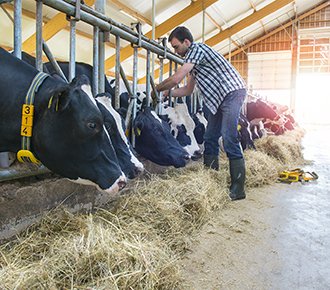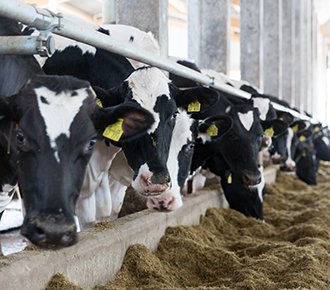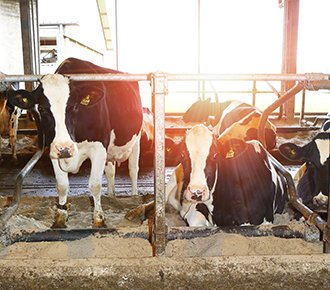- Sense of Sensors study
A lame cow eats for two hours fewer per day
Practical study Utrecht University, Wageningen University & Research, Vetvice and Nedap
Sense of sensors in transition management
On a dairy farm, there is certainly no shortage of data. Key performance indicators for milk production and livestock health have come to form an indispensable part of modern-day livestock farming and with the advent of sensors, the flow of data has expanded still further. In a large-scale practical study, Utrecht University, Wageningen University & Research, Vetvice and Nedap are seeking to identify a method that will make it possible to derive practical value from the information provided by sensors. In a series of articles, we will look over their shoulders as they carry out their research. In this edition: hoof health.
Hoof health
A lame cow eats for two hours fewer per day
Eight weeks after calving, more than half of cows experience a certain degree of lameness. As lactation progresses, the number of cows with a locomotion score of 3 or above rises. This has been confirmed by practical research.
The majority of livestock farmers already know that a lame cow walks and eats less than a healthy one. Practical research from Sense of Sensors research has now provided hard data to support this. The researchers scored the ‘locomotion’, or movement, of thousands of cows on eight farms over a period of one and a half years. The table shows how lame cows (score: 5) eat for 135 fewer minutes per day than non-lame cows (score: 1). They also eat less often, spend more time lying down in the stalls, and take half the number of steps.

Table: Eating behaviour of lame cows compared to non-lame cows (source: Sense of Sensors)
A daily marathon
In Part 5 of this series, we explore the fact that fresh cows suffer from hoof problems more often than dry cows (Figure 1). As cows progress through lactation, there is an increase in the number of animals with a locomotion score of 4 – the category below severe lameness. Eight weeks after calving, more than half of cows experience a certain degree of lameness (scores: 3, 4 and 5).
Graph: Locomotion score in various stages of transition

“Milk production increases rapidly following calving. As we know, at the peak of milk production, cows use as much energy as someone running one and a half marathons. And that’s every single day”, explains Peter Hut. According to the research coordinator, cows are able to do this as long as they are provided excellent shelter and care. The transition period is the most vulnerable in terms of hoof problems. In response to hormonal stimuli, the connective tissues around the hoof bone soften. This softening, combined with radical changes in metabolism, increases the risk of hoof disorders.
Veterinarian Jan Hulsen suggests that livestock farmers should be alert to four success factors: “In addition to the quality of the hoof, the most important factors affecting success in hoof stress management are hygiene and prompt action. If hoof quality is at risk during the transition period, it is essential to limit any stress on the hoof.” According to Hulsen, this can be achieved by encouraging cows to spend time lying down by providing spacious, comfortable stalls, and by reducing “standing time”, for example when waiting for milking or during herd handling at the feed fence. He advises livestock farmers to install rubber flooring in waiting areas, milking sheds and along the return route. In addition, short walking routes can contribute to ensuring hoof health among fresh cows.

The level of stress on the hoof is an important factor in successful management of hoof problems.
Hoof problems are often chronic
Sensors are not, in fact, suitable for detecting hoof ailments among cows. “The information comes too late”, explains Hulsen. “The research indicates that quite a lot of problems following calving are related to behaviour prior to calving. However, it is not clear exactly when the problems begin. We are aware that one group of cows continuously displays deviant behaviour.”
Hulsen and Hut suspect that cows in this group have developed chronic hoof ailments. Among those cows identified during hoof care as having problems, 70% had problems with their hooves during the previous inspection. “This type of cow is a constant problem. Professional hoof trimming is certainly of importance for these animals, but it is also necessary to avoid removing too much of the horn. They have sensitive skin, which makes each step painful”, acknowledges Hulsen.
It’s not all about the feed
Sensors can accurately monitor standing and feeding time. According to Hulsen, standing time is a good parameter for measuring the level of stress on hooves. Feeding time, and the number of feeding episodes, provide information about stall capacity and feed intake patterns. Both are important parameters for good hoof health. “Make sure that each cow has continuous access to tasty and appropriate feed, without selection. That’s vital, especially when they’re dry. A cow that eats continuously is likely to have a problem-free start to lactation”, claims Hulsen.
In the final analysis, nutrition is not the most important factor to adjust. According to Hut and Hulsen, hoof health begins with comfortable shelter, hygiene, and short walking routes. They believe that the effect of ‘rationing’ is overestimated, while the effect of sufficient feed intake tends to be underestimated. As Hulsen says: “Just try using feed to create hoof problems in a cow living in a deep stall: It can’t be done.”
Dairy farmer Jaap Hartman:
“This flooring is clearly more hoof-friendly for our milking cows.”
The cows are happy once more on Jaap Hartman’s farm. This dairy farmer from Toldijk renovated the flooring of his stalls in summer 2017. He chose ECO Floor from Anders Beton, a low-emission rubber flooring material. “The cows are clearly walking better on it: this flooring is more hoof-friendly. I was particularly interested in the flooring, as the cows wait in this part of the shed to be milked. Hartman earlier had the feed fence moved forward, and laid rubber on the exposed concrete. The cows definitely preferred using that strip, especially those with sensitive hooves. It’s too early to draw a firm conclusion based on the data provided by the sensors at Hartman’s farm. The herd uses both sides of the feed path, while the renovation has been completed on one side only. “However, I have noticed that we’re getting fewer sole ulcers and white line diseases. At the same time, the incidence of Mortellaro disease (digital dermatitis) seems to have increased. I think this is because the floor is damper.” The livestock farmer uses sensor data to identify animals with problems.

Related articles
Read more articles about the large-scale practical study Sense of Sensors in Transition Management.



